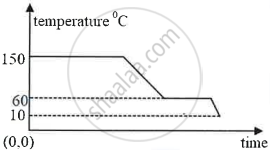Advertisements
Advertisements
प्रश्न
If pressure increases, the melting point of a substance ______.
पर्याय
does not change
decreases
increases
remains constant
उत्तर
If pressure increases, the melting point of a substance increases.
Explanation:
Most substances' melting points rise as pressure increases because the solid state is more compact than the liquid state. Higher pressure favors the solid phase, necessitating additional heat (higher temperature) to overcome this and cause melting. Ice is an exception to this rule, as its melting point decreases under pressure due to its unusual structure.
APPEARS IN
संबंधित प्रश्न
State two factors upon which the rate of emission of thermions depends.
State the effect of an increase of impurities on the melting point of ice.
What is the Greenhouse effect?
Write the approximate value of specific latent heat of ice.
Explain the following:
The surrounding become pleasantly warm when water in a lake starts freezing in cold countries.
Liquid ammonia is used in ice factory for making ice from water. If water at 20°C is to be converted into 2 kg ice at 0°C, how many grams of ammonia are to be evaporated? (Given: The latent heat of vaporization of ammonia = 341 cal/g)
A substance changes from its solid state to the liquid state when heat is supplied to it. What name is given to heat absorbed by the substance.
Explain why water is used in hot water bottles for fomentation and also as a universal coolant.
Give one consequence of the high specific latent heat of fusion of ice.
Explain, why no tracks are left on the ice during ice skating?
What do you understand by the ‘latent heat of vaporization’ of a substance?
What observation you will record and how will you determine the specific latent heat of fusion of ice?
Match the columns.
| Column A | Column B |
| 1) Absolute humidity | a) J or cal |
| 2) Latent heat | b) J/kg °C |
| 3) Specific heat capacity | c) kJ/kg |
| 4) Heat | d) no unit |
| e) kg/m3 |
Write the name.
Products obtained when sugar is heated.
Write scientific reason.
Even if boiling water is constantly heated, its temperature does not rise.
600 g of copper at 50°C is mixed with lOOOg water at 20°C. Find the final temperature of the mixture. The specific heat capacity of copper is 0.4 Jg-1°C-1 and that of water is 4.2 Jg-1°C-1
Calculate the total amount of heat energy required to melt 200 g of ice at 0°C to water at 100°C. (Specific latent heat of ice = 336 Jg-1, specific heat capacity of water = 4.2 Jg-1 °C-1)
The diagram below shows a cooling curve for a substance:

- State the temperatures at which the substance condenses.
- The temperature range in which the substance is in liquid state.
- Why do we prefer ice to ice-cold water for cooling a drink?
